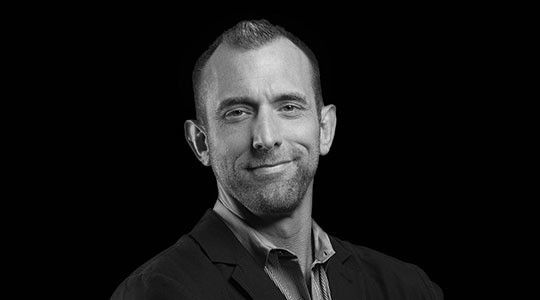
‘Being Uber’: Sapient Nitro on Brand Survival in the Age of Disruption

“If you look at most of our clients, they’re wrestling with ‘being uber’. It’s easy to use air quotes, but it’s a really big thing,” says Sapient Nitro’s Global CCO Donald Chestnut.
Things may be challenging in the advertising and marketing industries right now, but the broader business ecosystem is undergoing a disruption comparable to the Industrial Revolution. No one knows which sector is going to be hit next by a Dollar Shave Club or Uber and that means that clients need so much more than a big brand campaign or a fun little app from their digital agency partners.
Thankfully, the team at SapientNitro are used to pivoting – which makes them all the more able to help clients through the new normal of uncertainty and change. From its roots in the early ‘90s as a pure IT business to its move into creative and interactive marketing and its acquisition of Nitro in 2009, the agency has continued to reinvent itself, going deeper into businesses’ digital infrastructure, overhauling their data systems and leveraging technology to help them respond better to consumer needs. Being nimble and responsive and able to quickly incorporate new tech might be relatively easy for a cheeky start-up. Not so much for legacy businesses with thousands of employees and a digital infrastructure that’s more of an archaeological dig site of various systems layered up over the years.

Donald Chestnut
“The integration of all these things is difficult. You’ve got to get the business strategy, the creative ideas, the large scale technology,” says Sheldon Monteiro, SapientNitro’s Global CTO. “What’s really interesting right now is the speed with which brands need to embed requires them to move at a pace that they’ve just not been used to. Think about most traditional brands; they work in silos, fulfilment is very, very strong and they tend to buy from point providers and act as the integrators across those. What tends to happen is the competitors and start-ups like Dollar Shave Club will eat their lunch because they are working in agile sprints. Putting work into the real world every day.”
Given the challenges that brands face, it’s easy to see why Publicis Groupe shelled out $3.7 billion for SapientNitro and its sister divisions Sapient Global Markets and Sapient Government Services in early 2015.

Sheldon Monteiro
Another, equally salient point is that as clients become savvier it’s becoming more common to take certain elements of digital and social marketing in-house. To prove their value and remain relevant, digital agencies have to offer more, go deeper and help solve not only branding or communications problems but business problems.
“I’d also say our clients are becoming smarter than they ever were,” says Donald. “This is something I’d say externally and internally, five years ago it was easy for us to be the digital jack of all trades – now many of them are doing it with their internal teams. So what is the continued value add to help them see what’s next.”
This can take many forms. Machine learning technology can help brands update products on the e-commerce platforms more quickly. A smarter approach to data can help businesses react and respond to challenges and opportunities more nimbly – currently, many older businesses do own a huge amount of data but it’s stored and organised in a way that renders it next to useless.
But in pockets of the advertising and marketing world, big tech and big data is still viewed with suspicion – but Donald argues that it’s hugely creative, if not as easily consumable as campaign-based projects. While the major award shows reward projects based on their newness – who’s going to award an ‘old’ idea – so longer term projects are likely to fly below the radar even if they do deliver more substantial business impact.
“A lot of what we’re helping clients do are multi-year, multi-pronged projects. There’s a lot of creativity and a lot of great ideas but they’re embedded in a longer terms approach to a platform. And then I go somewhere like Cannes as a creative – and as a creative I love and respect what Cannes is about, which idea and craft – and I look at what wins and it’s parallel but separate from how I see the world,” says Donald.
Sheldon has an interesting – if not a little controversial – solution. “The provocation I’d like to offer up is that the category that Cannes needs most, that our clients need most and frankly world needs most right now is digital platforms,” he says.
“If you look at the number one challenge clients face at the moment, it’s that their businesses are being disrupted by a nexus of forces. One is an empowered consumer. Another is that there is competition coming in from sectors they’re not familiar with. There is the reinvention of business models. So, it’s not sufficient to just talk about your brand, you have to change every aspect of our business in order to deliver on customer expectations. Including reinventing your business platforms, the systems behind it, the processes to deliver on that brand promise. And that’s what customers are struggling with. IT requires an intersection of creativity, strategy and large scale technology.”
Despite the talk of digital platforms and IT infrastructure, the heart of what Donald and Sheldon and the team around the world are trying to do is to make life better for consumers. That’s the reason the disruptors are managing to disrupt after all – they offer a service that’s simple to interact with, is built around human behaviours and makes life easier.
“It goes back to people. With gratuitous campaign ideas or banner advertising… how much do you really engage in that? Our competencies go far beyond that. Now the best ideas coming up are the things that are truly service-orientated. When a brand is informing, when a brand is educating, when it is providing some digital extension that helps consumers as well as building the brand at the same time, it isn’t just there as some sort of interesting activation,” says Donald. “That, over the long run, is where clients are trying to go.”













